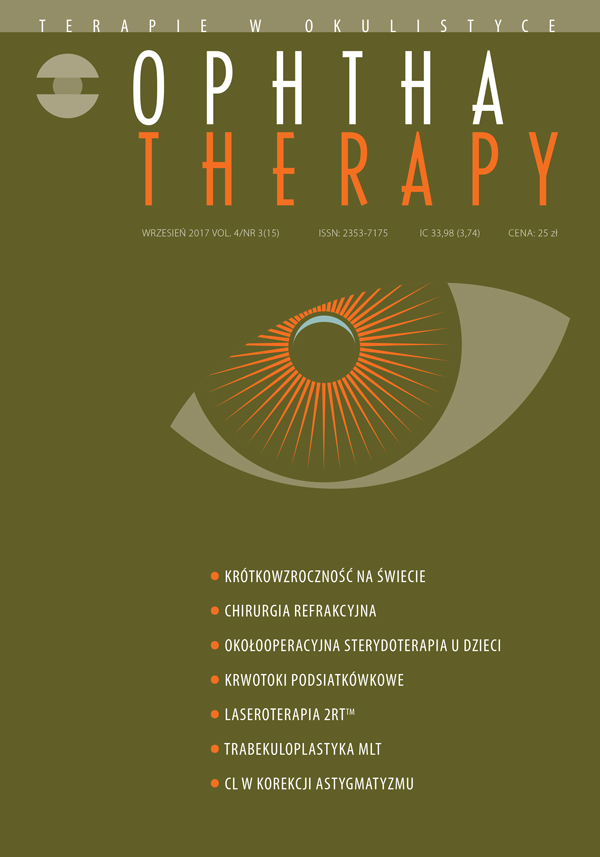The results of 3- and 6-month follow up in patients with dry AMD treated with 2RT laser
Main Article Content
Abstract
Bruch’s membrane thickening, which impairs nutrient and metabolite transport, constitutes the key aspect in the pathogenesis of age-related macular degeneration (AMD). As a result, the deposits (drusen) form between the retinal pigment epithelium (RPE) and Bruch’s membrane, causing degradation of both RPE and photoreceptor cells. It has been shown experimentally that pulse lasers may help decrease drusen size and improve metabolite transport through the Bruch’s membrane. Using a nanosecond pulse laser (2RT, Retinal Rejuvenation Therapy), operating at subthreshold energy levels, combines the beneficial laser effect with the prevention of laser-induced inflammation or photoreceptor damage. Below, we present the results of 2RTTM treatment in 610 patients with intermediate AMD, assessed at 3 and 6 months following treatment. The effect of treatment was assessed with Maia microperimetry (macular sensitivity assessment), optical coherence tomography (Spectralis HRA + OCT) as well as visual acuity and colour vision testing. Our findings included: an extreme improvement in macular sensitivity at 3 months following 2RT, with a subsequent decrease at 6 months, visual acuity improvements maintained at 6 months, yet without a correlation with OCT and colour vision improvement.
Downloads
Article Details

This work is licensed under a Creative Commons Attribution-NonCommercial-NoDerivatives 4.0 International License.
Copyright: © Medical Education sp. z o.o. License allowing third parties to copy and redistribute the material in any medium or format and to remix, transform, and build upon the material, provided the original work is properly cited and states its license.
Address reprint requests to: Medical Education, Marcin Kuźma (marcin.kuzma@mededu.pl)
References
2. Ferris FL, Davis MD, Clemons TE et al. A simplified severity scale for age-related macular degeneration: AREDS Report No 18. Arch. Ophthalmol. 2005; 123: 1570-4.
3. Gass JD. Photocoagulation of macular lesions. Trans Am Acad Ophthalmol Otolaryngol. 1971; 75: 580-608.
4. Chidlow G, Shibeeb O, Plunkett M et al. Glial cell and inflammatory responses to retinal laser treatment: comparison of a conventional photocoagulator and a novel, 3-nanosecond pulse laser. Invest Ophthalmol Vis Sci. 2013; 28: 2319-32.
5. Virgili G, Michelessi M, Parodi MB, et al. Laser treatment of drusen to prevent progression to advanced age related macular degeneration. Cochrane Database Syst Rev. 2015; 10: CD006537. https://doi.org/10.1002/14651858.CD006537.pub3 .
6. Chehade L, Chidlow G, Wood J et al. Review of short-pulse duration retinal lasers. Clin Exp Ophthalmol. 2016; 44: 714-21.
7. Jobling AL, Guymer RH, Vessey KA et al. Nanosecond laser therapy reverses pathologic and molecular changes in age-related macular degeneration without retinal damage. FASEB J. 2015; 29: 696-710.
8. Guymer RH, Brassington KH, Dimitrov P et al. Nanosecond-laser application in intermediate AMD: 12-month results of fundus appearance and macular function. Clin Exp Ophthalmol. 2014; 42: 466-79.
9. Ahir A, Guo L, Hussain AA et al. Expression of metalloproteinases from human retinal pigment epithelial cells and their effects on the hydraulic conductivity of Bruch’s membrane. Invest Ophthalmol Vis Sci. 2002; 43: 458-65.
10. Luu CD, Dimitrov PN, Robman L et al. Role of flicker perimetry in predicting onset of late-stage age-related macular degeneration. Arch Ophthalmol. 2012; 130: 690-9.
11. Ferris FL 3rd, Wilkinson CP, Bird A et al. Clinical classyfication of age-related macular degeneration. Opthalmology. 2013; 120: 844-51.
12. Bąk I, Markowicz I, Mojsiewicz M et al. Statystyka opisowa. Przykłady i zadania. Wydawnictwo CeDeWu, Warszawa 2015; 31-70; 185-94.

